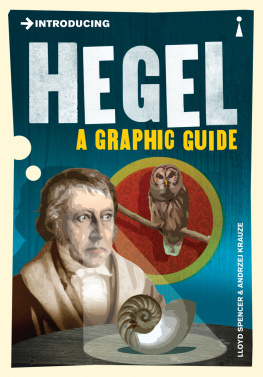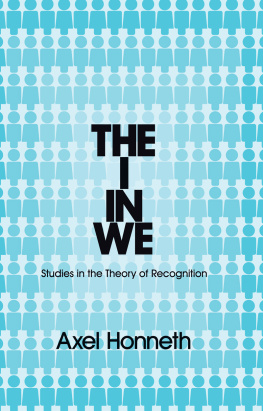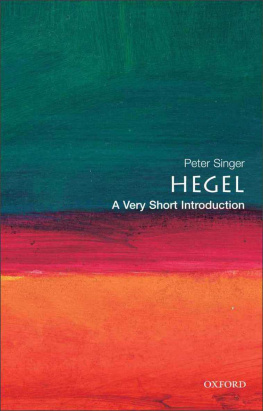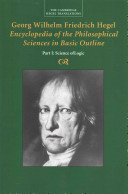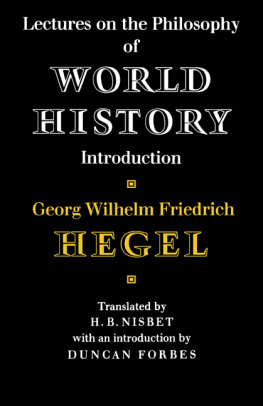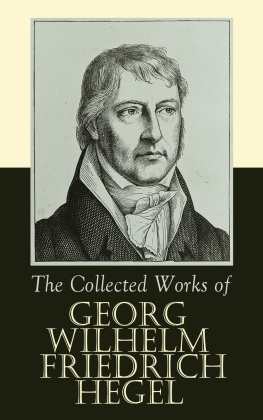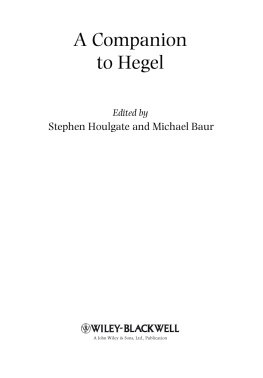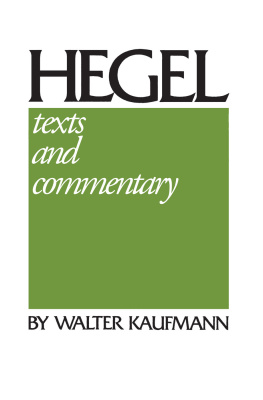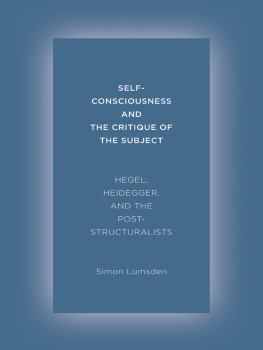Hegel Georg Wilhelm Friedrich - Hegel on Beauty
Here you can read online Hegel Georg Wilhelm Friedrich - Hegel on Beauty full text of the book (entire story) in english for free. Download pdf and epub, get meaning, cover and reviews about this ebook. City: New York;London, year: 2017, publisher: Routledge, genre: Science. Description of the work, (preface) as well as reviews are available. Best literature library LitArk.com created for fans of good reading and offers a wide selection of genres:
Romance novel
Science fiction
Adventure
Detective
Science
History
Home and family
Prose
Art
Politics
Computer
Non-fiction
Religion
Business
Children
Humor
Choose a favorite category and find really read worthwhile books. Enjoy immersion in the world of imagination, feel the emotions of the characters or learn something new for yourself, make an fascinating discovery.
- Book:Hegel on Beauty
- Author:
- Publisher:Routledge
- Genre:
- Year:2017
- City:New York;London
- Rating:5 / 5
- Favourites:Add to favourites
- Your mark:
- 100
- 1
- 2
- 3
- 4
- 5
Hegel on Beauty: summary, description and annotation
We offer to read an annotation, description, summary or preface (depends on what the author of the book "Hegel on Beauty" wrote himself). If you haven't found the necessary information about the book — write in the comments, we will try to find it.
Hegel Georg Wilhelm Friedrich: author's other books
Who wrote Hegel on Beauty? Find out the surname, the name of the author of the book and a list of all author's works by series.
Hegel on Beauty — read online for free the complete book (whole text) full work
Below is the text of the book, divided by pages. System saving the place of the last page read, allows you to conveniently read the book "Hegel on Beauty" online for free, without having to search again every time where you left off. Put a bookmark, and you can go to the page where you finished reading at any time.
Font size:
Interval:
Bookmark:
The Anthropological Roots of Beauty
Most commentators on Hegels aesthetics today hold that for Hegel, beauty is essentially an artistic phenomenon, and therefore, our analysis of Hegels notion of beauty has to begin with his theory of the artwork. However, the following observation should give us pause. When Hegel wishes to illustrate, in the Lectures on Aesthetics , what beauty consists of, he always refers to the same image: the living human figure, whose inner soul or spirit becomes visible in the body. In a famous passage in the Aesthetics ,the present and in following chapters, this experiment turns out to be fruitful: Hegels discussion of the relation between human soul and body turns out to have significant implications for Hegels assessment of the aesthetic potential of the human individual.
As sketched in the introduction, the discussion in the present chapter constitutes the first step of an argument aimed at refuting the predominant view that beauty is exclusive to art in Hegels view. In this first step, by discussing Hegels account of the aesthetic potential of the human being, I offer evidence that there may be beauty to be found outside of the sphere of art from Hegels point of view. In other words, I provide reasons for believing that objects other than artworksmore specifically, human beingscan be beautiful for Hegel. But the argument will not be complete until the following two steps have been taken as wellthat is, until the reasons adduced by commentators for holding the predominant view have been undermined, and potentially lingering worries have been dispelled. These further argumentative steps will be taken in the following chapters. Thus in the present chapter we are only beginning to embark on an argument that eventually is meant to establish that it is not the work of art, but rather the living human individual that constitutes the primary and paradigmatic instance of a beautiful object for Hegel.
In order to approach the question of whether the human individual might have genuine aesthetic potential in Hegels view, one has to begin by considering what distinguishes the human living organism from other organisms in this respect. In the Aesthetics , Hegel states that beauty is to be found in the realm of living, organic creatures, but he emphasizes that not every kind of living creature has the potential to be beautiful. Following the structure of Hegels argument, we will therefore begin with his discussion of the animal organism in the Aesthetics , and then work our way up until we have reached what constitutes the aesthetic pinnacle in the realm of living organisms for Hegel, the human individual.
The existence of living natural organisms constitutes for Hegel one of the most readily accessible and intuitively convincing corroborations for his idealist philosophyin the Aesthetics , he even calls the existence of such organisms an objective idealism, that is, an idealism that is openly perceptible in an object before our eyes.
Hegel makes it clear in the Aesthetics that he considers the unity and subjectivity of the living animal organism as a kind of proto-aesthetic phenomenon.
But while being aesthetically superior to non-living and vegetal nature in virtue of its subjectivity, the animal organism is nevertheless inferior in aesthetic respect to the human being. Hegel here does not make his line of argument fully explicit, but it seems to be grounded in the premise that what is necessary in order for a living subject to be aesthetically excellentthat is, ultimately, to be beautifulis that it possesses the capacity to make its inner soul wholly manifest in its external body. But the animal organism lacks this capacity, and this is the reason why it is aesthetically deficient, in contrast
Taken by itself, this argument is hardly convincing. It is not clear why one form of organic matterskinshould be more apt to manifest subjectivity than another; furthermore, some parts of the human body are covered with hair; large parts are usually covered with clothes; and some animals are naked. A more plausible account of what Hegel has in mind can be gained, I suggest, by considering his discussion of the relation between human body and soul, which forms part of his Anthropology, the first part of his Philosophy of Subjective Spirit. The upshot of this discussion, as we shall see, is that the human individual accomplishes a unity of inner soul and outer body that is uniquely humananimals cannot accomplish such a unity of inner and outer. Furthermore, this unity of inner and outer has aesthetic implications, as it is in virtue of their capacity to accomplish such unity that human individuals can overcome the aesthetic shortcoming of the animal organism just discussed. The central concept that Hegel draws on in this context is the notion of habit . In order to appreciate why it is relevant in the context of Hegels aesthetic theory, we need to consider in some detail his notion of habit as he develops it in the Anthropology.
A habit, one might think, is simply a pattern of regular behavior, which can be observed in animals as well as in human beings. A herd of animals, for instance, may form the habit of always attending the same watering against the sensation in question, that is, one will cease to sense it as strongly as before. However, whether the onset of the relevant mechanism or the effect of hardening does in fact occur is not under the subjects immediate control. Rather, this is an effect with regard to which she is passive. She is here dependent on her body reacting in an appropriate way to her deliberate attempts at formation.
From Hegels point of view, this shows that the successful acquisition of a habit involves essentially both our spiritual and our natural side. For Hegel, the essence of spirit is freedom. Thus, to the extent that the acquisition of habit involves deliberate, intentional actionthe deliberate, intentional repetition of the same course of actionit qualifies as a spiritual process. At the same time, to the extent that the acquisition of habit involves processes that are beyond the subjects intentional, deliberate control, such as the mechanization of bodily processes or the hardening against sensation, it qualifies as a natural process. Accordingly, the process of the acquisition of habits is partly natural, partly spiritual.
However, putting it this way is not yet quite accurate. Hegels view is not just that when human individuals acquire habits, they exercise on the one hand their spiritual side and on the other hand their natural side; he does not have in mind the combination of two heterogeneous elements. Rather, he holds that where human habits are acquired, a unity of spirit and nature manifests itself. That is to say, we are here presented with a process in which our spiritual and our natural sides are joined together or unified in one overall movement; moreover, this overall movement qualifies as a spiritual one. In other words, the acquisition of habits is for Hegel a spiritual process in which natural processes play an essential role. To see why this is the case, we need to look at one example of the acquisition of habits more closely. Let us consider Hegels example of the acquisition of bodily skill.
We can here draw on an example Hegel himself discusses at various places, the example of the skill of writing. The acquisition of writing skill requires the deliberate repetition of the same movements many times. Furthermore, human individuals do not possess something like an instinct for writing. Writing is a cultural technique, invented by humans, and typically employed for the pursuit of cognitively complex purposes such as communication and memorization. It is in this twofold sense that the acquisition of the skill of writing is an exercise of human freedom. On the other hand, to acquire the skill of writing means to develop certain mechanisms of movement. A skilled writer is characterized by the fact that when she wishes to write a word or sentence, she only has to pursue the overall purpose of writing the word or sentence, and her fingers will carry out the relevant movements mechanically, without her having to think about how exactly to move her fingers. This aspect of the possession of skill also has a phenomenological side. We can illustrate this in light of the example of writing. Let us suppose a subject learns to write the capital printed letter A. Someone demonstrates to her how to write a capital A in printed letters, instructing her to draw three lines, of different lengths and at different angles. She has never performed this sequence of movements before. As she now tries to follow the demonstration, she deliberately performs three different bodily movements, making an individual effort for each one, thereby drawing three different lines. As a result, the three lines she has drawn end up constituting the capital letter A. What is crucial about this process as described here is
Font size:
Interval:
Bookmark:
Similar books «Hegel on Beauty»
Look at similar books to Hegel on Beauty. We have selected literature similar in name and meaning in the hope of providing readers with more options to find new, interesting, not yet read works.
Discussion, reviews of the book Hegel on Beauty and just readers' own opinions. Leave your comments, write what you think about the work, its meaning or the main characters. Specify what exactly you liked and what you didn't like, and why you think so.



